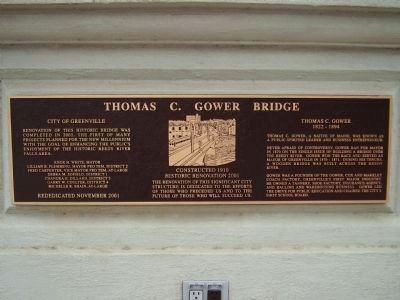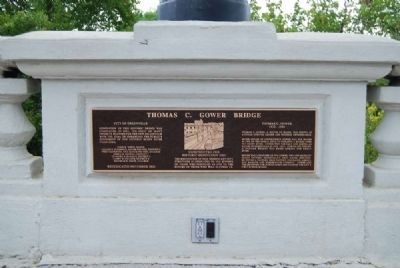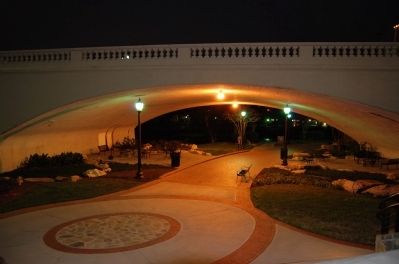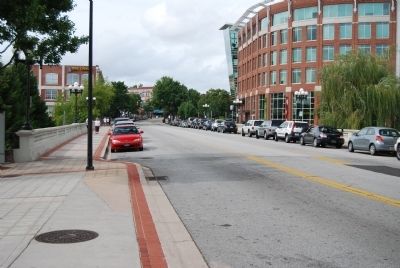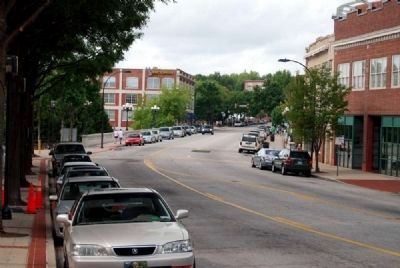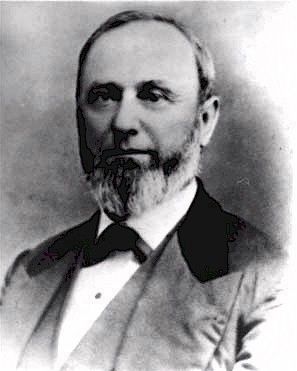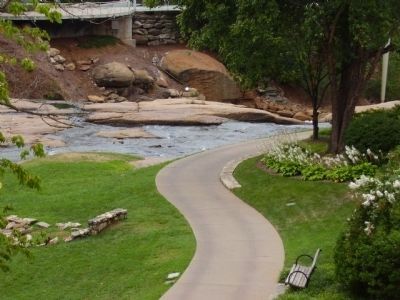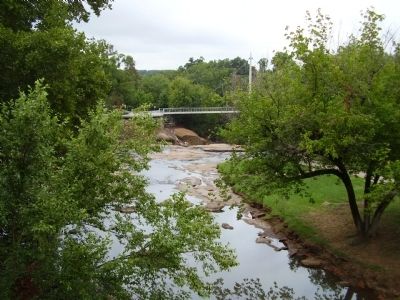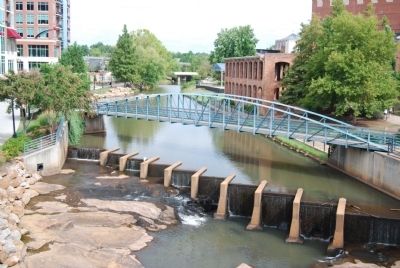Greenville in Greenville County, South Carolina — The American South (South Atlantic)
Thomas C. Gower Bridge
Lillian B. Flemming, Mayor Pro Tem, District 2
Fred Carpenter, Vice Mayor Pro Tem, At-Large
Debra M. Sofield, District 1
Chandra E. Dillard, District 3
Garry W. Coulter, District 4
Michelle R. Shain, At-Large
Rededicated November 2001
Constructed 1910
Historic Renovation 2001
The renovation of this significant city structure is dedicated to the efforts of those who preceded us and to the future of those who will succeed us.
Thomas C. Gower
1822-1894
Never afraid of controversy, Gower ran for Mayor in 1870 on the single issue of building a bridge over the Reedy River. Gower won the race and served as Mayor of Greenville in 1870-1871. During his tenure, a wooden bridge was built across the Reedy River.
Gower was a founder of the Gower, Cox and Markley coach factory, Greenvilles first major industry. He owned a Tannery, Shoe Factory, Insurance Agency, and Hauling and Warehousing business. Gower led the drive for Public Education and chaired the City's first School Board.
Erected 2001 by City of Greenville.
Topics. This historical marker is listed in these topic lists: Bridges & Viaducts • Education • Industry & Commerce. A significant historical year for this entry is 2001.
Location. 34° 50.747′ N, 82° 24.083′ W. Marker is in Greenville, South Carolina, in Greenville County. Marker is on S Main Street (State Highway 124), on the left when traveling south. Marker is on the railing of the Thomas C. Gower Bridge. Touch for map. Marker is in this post office area: Greenville SC 29601, United States of America. Touch for directions.
Other nearby markers. At least 10 other markers are within walking distance of this marker. About 1765 (within shouting distance of this marker); The "Swamp Rabbit" Railroad (within shouting distance of this marker); Vardry Dixon Ramseur, III (within shouting distance of this marker); Falls Place (within shouting distance of this marker); Welcome to Falls Park (within shouting distance of this marker); Liberty Bridge (within shouting distance of this marker); Eugenia Duke Bridge (about 300 feet away, measured in a direct line); Dr. Charles Hard Townes (about 300 feet away); Tate Plaza (about 300 feet away); Wyche Pavilion (about 300 feet away). Touch for a list and map of all markers in Greenville.
Additional commentary.
1. Gower Main Street Bridge
The walkway from the Reedy River Falls brings you to the Gower Bridge on Main Street. The bridge's namesake is Thomas C. Gower, an ambitious man who migrated from Maine to Greenville in 1842. He sought a position in his brother's coach factory on the northern bank of the reedy River. Immediately next to the factory was a rickety wooden footbridge that crossed the ford at Greenville's Main Street. Gower had firsthand experience of seeing the problems the bridge caused daily for businesses and pedestrians alike. After barely weathering the economic ruin brought on by the Civil War, this well-respected businessman ran for mayor of Greenville in 1870 with a platform that consisted primarily of putting the first substantial bridge across the river. A large opposition, including the incumbent major, was against the plan because of the large expense for taxpayers. Gower won the mayoral race, city council voted to fund $1,500 and work began on the new wooden bridge. T.C. Gower's other significant contribution to Greenville's transportation was his startup of the first streetcar system in 1875.
A second, stronger structure came in 1890 when an iron bridge was erected by the Southern Bridge Co. to meet the needs of a growing city and a new generation. Horse and carriage was still the primary means of transportation when the bridge was finished and there were rules for their use on the bridge. A few years after cars began to appear in town, Greenvillians caught riding their horses across the bridge instead of walking them could be fined five dollars. By the end of the first decade of the twentieth century, even the iron bridge would be insufficient for the heavier weights and wear of cars. Like its predecessor, the iron bridge also lasted twenty years before having to be replaced. What spans the river now is the third substantial bridge across the river on Main Street. It was constructed of concrete by J.E. Sirrine in 1910. A year later, Greenville County had three hundred car owners and Main Street was completely paved. Three years later the number increased to just over one thousand - more than any county in South Carolina. This concrete bridge has lasted nearly a century, servicing Greenville's ever-increasing traffic. In 2000, the bridge received a full restoration and was rededicated as the Gower Bridge in honor of the man whose vision lives on today in the spirit of many of Greenville's current entrepreneurs. (Source: A Guide to Historic Greenville, South Carolina by John M. Nolan (2008), pgs 29-30.)
— Submitted December 6, 2011, by Brian Scott of Anderson, South Carolina.
2. Early Main Street Bridges
The distance, "across the river." in old parlance, is very muchshortened by the regular grade of the street, and by the high bridge over Reedy river. The first bridge I can remember was a substantial foot log. This was twice replaced, in successive years, by foot bridges, the abutments of which are still to be seen a little above the present structure. But it was in the administration of Mr. Thomas C. Gower as mayor of the town that the present bridge was built. It was'opposed by many at the time, upon the ground of the expense involved, and indeed was a main issue in one of the municipal elections, but Mr. Govver carried his point, and his judgment has since been amply vindicated. The saving in time, labor, and wear and tear of vehicles, by the change from the old fashioned way of fording the river, is probably equal to the cost of the bridge in any one year. It was called Gower's bridge for many years and is still an honorable monument to his memory. It was required to be raised several years ago to allow the engines of the "Swamp Rabbitt" Railroad to pass under. (Source: The Greenville Century Book: Comprising An Account of the Settlement of the County, and the Founding of the City of Greenville, S.C. by S.S. Crittenden (1903), pg 42.)
— Submitted December 6, 2011, by Brian Scott of Anderson, South Carolina.
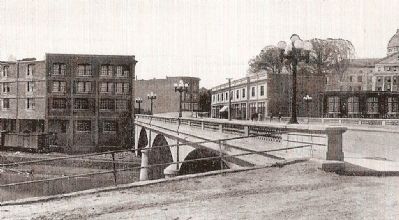
Special Collections, South Carolina Library, USC Columbia, 1911
7. Thomas C. Gower Bridge
At the time, known as the Main Street Bridge. The domed building to the extreme right is Chicora College, a Presbyterian college for women. Built in 1895, the school merged with Queens College in Charlotte, North Carolina in 1915. The stately campus burned down in 1919.
Credits. This page was last revised on June 16, 2016. It was originally submitted on August 25, 2008, by Stanley and Terrie Howard of Greer, South Carolina. This page has been viewed 1,928 times since then and 41 times this year. Photos: 1. submitted on August 25, 2008, by Stanley and Terrie Howard of Greer, South Carolina. 2. submitted on December 6, 2011, by Brian Scott of Anderson, South Carolina. 3. submitted on December 28, 2008, by Brian Scott of Anderson, South Carolina. 4. submitted on September 2, 2008, by Brian Scott of Anderson, South Carolina. 5. submitted on December 6, 2011, by Brian Scott of Anderson, South Carolina. 6, 7. submitted on April 14, 2009, by Brian Scott of Anderson, South Carolina. 8, 9. submitted on August 25, 2008, by Stanley and Terrie Howard of Greer, South Carolina. 10. submitted on August 28, 2008, by Brian Scott of Anderson, South Carolina. • Kevin W. was the editor who published this page.
